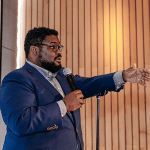Unlocking Insights: 3 Inspiring Highlights from the Advancing Research 2024 Conference

Rosenfeld Media’s Advancing Research 2024 conference was a gathering of minds and a celebration of innovation in the field of UX research and design—in-person for the first time since its inception! From captivating keynote sessions to thought-provoking panel discussions, attendees left the conference feeling invigorated and inspired.
Our carefully curated program showcased the best and brightest in UXR, providing valuable insights into the latest trends and challenges in the field. The program consisted of two themes: Excellence in Strategic Influence, and Excellence in Our Craft. Both days were crafted around these central ideas, and pushed the envelope in regards of what UX researchers have the power to do, through elevating their research practice, and executing influence outside of it!

Plus, an in-person conference all meant ample opportunities for attendees to connect their fellow UX research peers. Through facilitated networking sessions and informal discussions, participants were able to share experiences, exchange ideas, and build valuable connections. We also had book signings taking place throughout both days; dedicated fans were able to get copies of their favorite Rosenfeld books (and sometimes more than just books!) signed by Maria Giudice, Rebecca Evanhoe, Tomer Sharon, and Steve Portigal!


Advancing Research 2024 showcased cutting-edge research projects from leading organizations and research teams in over a dozen talks. These presentations highlighted innovative methodologies, groundbreaking findings, and best practices in UX research, inspiring attendees to push the boundaries of their own research endeavors.
Panel discussions at the conference explored emerging trends and future directions in UX research and design. Our amazing speakers shared their perspectives on topics such as AI-driven research, inclusive design, ethical considerations, and the evolving role of researchers in product development.
Now, while we can’t recap the entire two-day conference experience in one blog post, we can give you the highlights.
So, here are three key takeaways we haven’t stopped thinking about since March:
The importance of culture beyond diversity

According to Victor, colonial ways of being and extractive research methods do not produce liberatory knowledge. By leveraging a diverse toolkit of research methodologies, researchers can gain a more comprehensive understanding of user needs and behaviors. It’s all about going beyond cultivating awareness and how we can actually embrace diversity in research—and dismantle the oppressive systems around us.
Researchers have the power to change the status quo

On the #AR2024 stage in New York City, Robin Beers said, “The impact you can have is much bigger than this quarter’s results, or a feature launch. You have an opportunity to make the organization visible to itself, and help it understand where it is in and out of alignment with what customers need.” Robin’s talk highlighted tools such as Jay Galbraith’s star model and Chris Argyris’ double loop learning as ways to reflect organizations’ underlying assumptions. In instances such uncovering biases in AI, researchers have the power to create meaningful change. When using research insights to disrupt an organization’s culture, be explicit, anticipate resistance, build support, play the long game, and trust your gut.
When it comes to AI, take the user out of UX

Tricia Wang closed out day 1 with an enlightening talk about AI. By advocating for a shift from “user researchers” to skilled navigators of human-tech interactions, she sees us as key players in shaping the future with AI. By transitioning from being mere users to becoming shapers of AI, we shift from solely relying on digital tools to actively shaping them.
*
We’re so happy with the way Advancing Research 2024 turned out! It was a non-stop program filled with valuable insights and actionable strategies for how we can advance our research practices. From embracing diversity in research methods to harnessing the potential of AI and making an impact within an organization, the conference underscored the importance of innovation, empathy, and ethics in the field of UX research and design.
Missed out on #AR2024? Purchase the conference recordings to watch two days of talks and gain access to sketchnotes, session notes, resource lists, and more for 90 days!
Experience the Future of Research at Advancing Research 2024
Don’t miss the chance to join researchers from around the world at Advancing Research 2024! Advancing Research brings together the best minds in UX research, and this year those minds will be together at the Museum of the Moving Image in New York City—the first time this conference has been in-person since its inception four years ago!
What topics will Advancing Research 2024 cover?
Our research-driven program, carefully crafted by experts, includes two days of sessions led by pioneers in the field centered around what’s top-of-mind for UX researchers in 2024. And this year, the Rosenfeld community got to participate in part of its planning!
Back in August, we held a series of six public, free workshops covering many of the most important topics facing UX researchers today—partnering with AI, emerging methods advancing UX research, creating actionable insight in the face of politics and silos, making UX research leadership more effective, learning from other research practices, and what UX research “maturity” looks like. These six topics were discussed and debated by UX research experts and that laid the foundation for the program our curation team has since created! In fact, you may recognize a few familiar faces in our speaker lineup! Interested in getting a sneak preview of some of our speakers and their talks? You can watch the recordings of these community workshops here.
Who will be speaking at the Advancing Research 2024 conference?
Meet our featured speakers—Neil Barrie, Steve Portigal, Victor Udoewa, and Tricia Wang. These four will be opening and closing out each day of the conference with conversations about product and culture, inclusion in UX, advancing the field of UX research, and collaborating with AI.
Tricia Wang

Tricia Wang, a social scientist, consultant, and thought leader, is on a relentless quest to ensure technology serves humanity, fostering social impact at the intersection of data and humanity. Renowned for helping companies unearth pivotal customer behavior insights to unlock growth, Tricia co-founded Sudden Compass and has advised industry giants like Google, Spotify, and P&G. As an acclaimed speaker, Tricia’s enlightening keynotes and her TED Talk delve into AI, data, and their societal, economic, and personal impacts. Currently penning a book on how humans can be more human in the age of AI, Tricia is documenting an emerging skillset amongst those who work well with AI.
See Tricia at her talk, Redefining Research: Welcome to A New Paradigm with AI.
Victor Udoewa

Having started his career in the design and development of computational tools for scientific applications, Victor shifted his focus to the social impact space and Information and Communications Technologies for Development, both community and international development. He is a practitioner and advocate of participatory design, a meta-methodology he’s used in service and system design for governments, multilateral institutions, nonprofits, for-profits, and communities, to facilitate skill-building and improved employment opportunities for community members. Bitten by the “civic-innovation bug” he is now focused on creating or improving government products and services for citizens, immigrants, and refugees.
Victor has a particular love for design, learning, and design education. He advocates bringing practices such as positive deviance, pluriversal methods, and systems practice into civic design. He helps leads an equity-centered meetup group and Justice by Design as part of his work to decolonize design. Outside of work you can find Victor teaching salsa, singing with his a cappella group, volunteering as a health trauma and crisis counselor, or (mostly) hanging out with his family.
Come watch Victor at his session, Beyond Methods and Diversity: The Roots of Inclusion.
Steve Portigal

Steve Portigal is an experienced user researcher who helps organizations to build more mature user research practices. Based outside of San Francisco, he is principal of Portigal Consulting, and the author of two books: Doorbells, Danger, and Dead Batteries and Interviewing Users.
He’s also the host of the Dollars to Donuts podcast, where he interviews people who lead user research in their organizations. Steve is an accomplished presenter who speaks about culture, innovation, and design at companies and conferences across the globe.
Meet Steve at his session, Looking Back…to Look Ahead.
Neil Barrie

Neil Barrie is an industry thought leader with papers and pieces published in Fast Company, Guardian and Forbes.
Led brand strategy development for the likes of Airbnb, Netflix, Pinterest, Disney, Depop and N26.
(Ad)venturing background at Zag, the ventures arm of BBH partnering with finance, media and entertainment disruptors.
Commercially Creative: during both his years as CSO of Chiat Day LA the agency achieved the joint highest global Effie ranking, sits on the IPA’s Executive Leadership Group and mentor at Techstars Berlin.
Failed Rock Star: graced the stages of London, Paris and Leicester.
See Neil at his talk, Widening the Aperture: The Case for Taking a Broader Lens to the Dialogue between Products and Culture.
We don’t just have these amazing featured speakers opening and closing out each day of the conference—we have even more fantastic speakers sharing their talks all day March 25 and 26.
What does the conference schedule look like?
We’re so glad you asked. You can browse our full program in detail here, and view our schedule at a glance below.
Will there be in-person workshops at Advancing Research 2024?
We’re thrilled to be offering in-person workshops on March 27! Join us for a day full of hands-on learning from experts in the UX research space. Archana J. Shah and Subhasree Chatterjee, Nick Fine, and Steve Portigal will be leading workshops covering topics such as Artificial Intelligence, holistic insights through quantitative research methods, and techniques for user interviews.
Join Archana Shah and Subhasree Chatterjee for their workshop at Advancing Research 2024: Quantitative Methods for Qualitative UX Researchers

Many UX researchers often rely on familiar qualitative methods such as interviews and usability testing, overlooking the potential benefits of combining these with quantitative methods through triangulation. Depending solely on one set of tools can result in blind spots, limiting researchers’ ability to provide comprehensive insights. This workshop aims to address these challenges by offering insights into:
- When and how to apply quant methods for generative and evaluative research.
- How to supplement qual with quant and triangulate different data sources and methodologies to build a holistic story.
- The power of collaboration between researchers and data scientists, and how it can help drive a more data-driven culture across the organization.
Archana J. Shah is a Principal UX Researcher at LexisNexis Legal & Professional in Raleigh, NC, bringing over 15 years of experience in the tech industry. With a commitment to research advocacy, she excels in triangulating insights from various data sources, contributing to impactful changes and informing product development.
Subhasree Chatterjee is a Data Analytics Manager at LexisNexis Legal & Professional in Raleigh, NC, USA. She has more than 10 years of experience working in Data Analytics field generating actionable, interpretative, and implementable insights for different business problems. In her current role, she is leading a team of Product Analysts integrated with multiple product teams to drive data driven decisions across North America. She is a big proponent of combining qualitative and quantitative data to guide decisions in every stage of product development.
Learn from Nick Fine at Advancing Research 2024 with his workshop, Using AI to Support User Research

AI is changing the world, and UX is currently in a period of flux where everything is changing within the context of an unsure AI future. Researchers have many questions that this workshop will answer:
- How can you use AI to increase your value to your organization?
- How can you defend against being replaced by AI?
- What are the pitfalls and dangers of using AI to support User Research?
- How can you use AI safely to take some of the heavy lifting without major risk?
Dr. Nick Fine is an award-winning user experience researcher and designer with over twenty years of experience. He is the creator and founder of UX Psychology, advocating for behavioural design, and is also a science advocate and educator. Learn from Nick at #AR2024, both at his talk and his workshop.
Don’t miss Steve Portigal’s workshop at Advancing Research 2024, Interviewing Users: Uncovering Compelling Insights

Interviewing is undeniably one of the most valuable and commonly used user research tools. Yet it’s often not used well, because:
- It’s based on skills we think we have (talking and even listening)
- It’s not taught or reflected on, and
- People tend to “wing it” rather than develop their skills.
Results may be inaccurate or reveal nothing new, suggesting the wrong design or business responses, or they may miss the crucial nuance that points to innovative breakthrough opportunities.
In this highly interactive workshop, you will learn crucial techniques for successful user research, and have the opportunity to practice and reflect in a supportive environment.
Steve Portigal is an experienced user researcher who helps organizations to build more mature user research practices. Based outside of San Francisco, he is principal of Portigal Consulting, and the author of two books: Doorbells, Danger, and Dead Batteries and Interviewing Users.
Our workshops are designed with you in mind. They combine the cutting edge expertise of some of the world’s leading UX experts with the same high quality that people love about Rosenfeld Media’s UX books and conferences. And at Advancing Research 2024, we’re excited to have an excellent selection of workshops to choose from. Complement your conference ticket with a workshop. In fact, we have bundle tickets!
Did you know that when you bundle a conference and a workshop, you save $100? Maximize your learning this year by registering for both, and leave #AR2024 feeling invigorated and inspired.
We hope you join us at the Museum of the Moving Image in New York City this March 25-27, 2024 for the first ever in-person Advancing Research conference and workshops! Start your year with the groundbreaking conference made by researchers for researchers.
Don’t wait to register—early bird pricing is ending soon! Get your tickets now through February 6 to save up to $300!
See you soon!
— The Advancing Research team
Enhance Your Digital Note-taking with Jorge Arango’s Newest Release, Duly Noted: Extend Your Mind Through Connected Notes
Virtually everyone takes notes: the grad student transcribing a dense lecture, the doctor tracking patient progress, the friend adding your newest movie recommendation to their digital notepad. We constantly absorb information, and often seek to capture that material and document it for later use. But take note (pun 100% intended!): the everyday practice of jotting down information holds more power than you think.
Become a better note-taker to unlock ideas and productivity
The way we take and use our notes can be the difference between unhelpful clutter and critical tools for success. By becoming a better note-taker, you’ll become a better reader, a better writer, a better student, a better teacher, a better thinker—essentially, a better you. Jorge Arango’s newest book, Duly Noted: Extend Your Mind Through Connected Notes, teaches you how to streamline your digital note-taking, organize recorded information, connect your ideas, and supercharge your thinking.

In Jorge’s recent interview on The Rosenfeld Review podcast, he stresses that “externalizing thoughts [through note-taking] is one of the most powerful means we have… one of the most powerful means you have… to think better. And the ‘humble’ note… something that we use every day… if we use it mindfully, if we learn to use it a little bit better, we’re going to be better thinkers.”
What will you gain from reading Duly Noted?
You may think there’s nothing new to learn about note-taking. You’ve been doing it in some form or another since you could write, or even draw! You might say that note-taking is a matter of personal preference and isn’t something that can be done “correctly” or “incorrectly.” And while yes, no one is doing it “incorrectly,” everyone can still benefit from doing it better. Duly Noted provides note-taking best practices so you can take more concise, useful, and organized digital notes. You’re already doing the work, so why not “work smarter, not harder” and give yourself the gift of cohesive, thought-inspiring notes!
When you take your note-taking abilities to the next level, you’ll optimize the work you’re already doing. Throughout your life, you’re always going to be taking notes, so why not learn how to make those notes serve you better?
Within the pages of this book, you’ll find tips on how to consolidate your digital notes in a clear, meaningful way so you can more easily find them—and make sense of them—later on. You’ll also discover how notes can facilitate collaboration with other thinkers, and even AI! What’s more, Duly Noted will walk you through taking your notes in Obsidian, a powerful contemporary digital note-taking tool.
Who should read Duly Noted?
Are you a master’s student? A PhD candidate? A writer? A “creative”? Or anyone surrounded by countless scribbled and typed notes—on paper, on your phone, on your laptop? Duly Noted will show you how to clearly group these bits and pieces of information, and how to set up future-you for success. There’s nothing worse than looking at your notes after the fact and going, “Huh. What was this about? What does this mean?”
If you have minimal time and need to maximize your productivity, Duly Noted can help you turn your untamed thoughts (the “wilderness of your mind”) into an organized, well-maintained “knowledge garden.”
What readers are saying about Duly Noted
Andy Polaine, leadership coach and co-author of Service Design: From Insight to Implementation, says, “In an age of information overload, Duly Noted is a perfectly pitched guide to the principles and practices of connected thinking and tending to your personal knowledge garden.”
Nicole van der Hoeven, YouTuber and Senior Developer Advocate at Grafana Labs, says, “Duly Noted is the definitive book on taking digital notes and creating a modern, methodology-light system for thinking deeply.”

Take a sneak peek inside the book
Ready to dive into the realm of thought transformation? With Duly Noted, you’ll discover how to unleash the power of note-taking through the use of tools, practices, and frameworks that elevate your digital note-taking game.
But don’t take our word for it; check out Duly Noted for yourself: This free sample chapter will give you an idea of what’s in store.
Meet the author: Jorge Arango

In his design consulting practice, San Francisco-based information architect and strategic designer Jorge Arango collaborates with product, design, and innovation leaders to create digital spaces that make people smarter. He’s the author of Living in Information: Responsible Design for Digital Places and co-author of the fourth edition of Information Architecture: For the Web and Beyond. Jorge is a frequent speaker at global UX conferences and serves as an adjunct professor in the Interaction Design program at the California College of the Arts.
Some changes for 2024
2023 is done. Put a fork in it. Fini! And thank goodness.
Moving right along: we’ve got a couple of interesting things queued up at Rosenfeld Media HQ for 2024.
A community that’s easier to use, more wide-ranging in its coverage
First off, we’re making a major change to the Rosenfeld communities (DesignOps, Advancing Research, Enterprise Design, and Civic Design), combining them into a single Rosenfeld community. These curated communities have been educating and connecting, for free, thousands of UX and product people through monthly webinars and conversations, newsletters, and Slack-based discussions. Some go all the way back to 2017. Why would we change this?
Because you and your interests are evolving. So it doesn’t make much sense for Rosenfeld to invest in the same four topics year in and year out—especially at the expense of exploring new areas with you. And there are so, so many new topics on our collective minds (off the top of my head, climate UX, portfolio design, and everything AI).
Instead, we’ll publish one newsletter (more on that below), host a variety of free calls, and Slack discussions that cover a broader and more timely range of topics. We’ll continue to host curated DesignOps and Advancing Research-both videoconferences and Slack discussions—and we’re already entertaining hosting and supporting new interest groups within our consolidated community. (Have a topic in mind? We’d love to hear more.)
Long story short: the new Rosenfeld community will be easier for you to use and for us to maintain. And best of all, a more welcoming home for new topics that you want to discuss.
Reporting on Rosenfeld and more
Second, we’ve just launched the Rosenfeld Report, a new newsletter. “New newsletter” you groan? Who wants one of those? Well, as you’re already reading this, you probably do. In a nutshell:
- There’s so much to keep track of—even just the news out of Rosenfeld Media—that consolidating to one newsletter is a no-brainer. Now you’ll know where to look to keep track of our conferences, new book pre-order announcements and other deals, all the free community events we produce, and more.
- Each issue includes a handful of the most important things you can read about UX and product design, curated by Uday Gajendar. In other words, our newsletter will literally make you smarter.
- We’ll send it every two weeks—nice and predictable, so you can quickly scan it.
Having one newsletter will also reduce the number of announcements we send out overall. We’d like that, and we’re guessing you would too.
If you’re already subscribed to our other newsletters or announcement lists, you won’t need to do anything; you’ll just notice fewer, more useful communications from us. If you’re not, please subscribe here (and tell your pals to do the same). You can preview our first issue, which debuted December 5, here.
What else is happening at Rosenfeld? Lots of new books, a new conference, and the launching of our long-awaited membership service in the new year. I’ll dig into these in more depth very soon—and if you don’t want to miss any of it, be sure you (ahem) subscribe to the Rosenfeld Report.
Explore Rosenfeld’s Newest Release, Design That Scales: Creating a Sustainable Design System Practice
As the world becomes increasingly more digital, design systems are becoming increasingly more important. With roughly five billion daily internet users, designing websites and apps at scale is critical to meeting the increasing demand for online information and services. But building successful design systems is no easy feat, and limited resources exist to support designers, engineers, and product people as they advance in their careers.
In his forthcoming book, Design That Scales: Creating a Sustainable Design System Practice, design-systems expert Dan Mall draws upon his experiences helping popular brands create sustainable, successful design practices.

What will you gain from reading Design That Scales?
Design systems are not just for designers. Mall notes that these systems are highly valuable because they “serve the proverbial three-legged stool of design, engineering, and product.” Unfortunately, however, “most design systems fail because they aren’t integrated early enough into the grain of how an organization operates.” Design That Scales serves to guide readers away from that pitfall.
Not only will you learn how to create, manage, and sustain a successful design system, you will also gain a comprehensive understanding of the various components of a design system—and how they contribute to success. You’ll foster a culture of collaboration by discerning where each contributor fits within a design system team. You’ll learn how to measure a design system’s impact and demonstrate its value to stakeholders. Plus, end-of-chapter questions will help you steer your design system towards a profitable outcome.
Design That Scales is a must-read for:
- Individuals involved in building and maintaining design systems, regardless of size
- Designers, engineers, and product managers seeking more efficient ways of working
- Leaders and executives looking to drive meaningful change within their organization
- Those who have experience designing web forms and tables but are unsure what’s next
What readers are saying about Design That Scales
Nadine Sarraj, Product Designer at 365 Retail Markets, says, “Dan’s book is a game-changer for our approach to design systems, leading to significant changes at my company, making it a must-read for streamlining anyone’s complex design systems! This book equips you with everything you need for your next design system transformation.”
Afyia Smith, Design Manager at Epic Games, says Design That Scales “will be my go-to resource for creating and managing design systems as they grow.”

Take a sneak peek inside the book
Design That Scales is a treasure trove of wisdom for both design system novices and seasoned practitioners alike. It not only provides guidance on building a successful design system, but also delves into the crucial aspects of measuring its success.
Want more? Check out a sample chapter for a taste of what you’ll find.
Happy reading, and enjoy your journey into the world of design systems!
Meet the author

Hailing from Philly, Dan Mall is a multi-talented creative force: an esteemed teacher, creative director, designer, founder, and entrepreneur. To help enterprise teams design at scale, he crafts, collects, and curates curriculum, content, and community at Design System University, his brainchild. Previously, he helmed SuperFriendly, a renowned design system consultancy. Dan discusses design systems, process, leadership, and more on his website, danmall.com.
Design in Product 2023 Full Program Announced
We’re excited announce the full program and workshops lineup for Design in Product 2023! On November 29-December 1, these experts will take the stage to tackle real questions and discussions surrounding the design and product fields.
What is Design in Product 2023 about?
Design in Product is a conference dedicated to the intersections of—you guessed it—Design and Product. Whether you’re moving into a product role, or looking to be a better partner with product peers, Design in Product will prepare you for success in product-centric organizations.
This year’s conference is centered around three themes.
- Aligning and partnering—Nailing the basics of alignment and partnership are table stakes for getting past the friction that often plagues the PM/UX relationship.
- Setting and defending priorities—Product managers and UX practitioners need to work together to set priorities, develop roadmaps.
- Influencing and politcking—Product managers seem to have mastered the trick of influencing without authority. Can UX practitioners learn to do the same?
Who are the keynote speakers for Design in Product 2023?

Ellen Chisa is a Partner at boldstart ventures investing in enterprise infrastructure, SaaS, and developer tooling companies. Before joining the boldstart team in January 2021, she was the CEO & co-founder of Dark (https://darklang.com) a programming language coupled to its editor and infrastructure.
Her opening keynote, The Values of Design, has the aim of answering questions such as “How can I create more business impact, while still feeling like a designer?”

John Cutler focuses on the messy overlaps and patterns of product—The Beautiful Mess (the title of his newsletter). John currently supports product teams at Toast as Senior Director, Product Enablement. Before Toast, he interacted with diverse product teams and product leaders worldwide as a product evangelist and coach at Amplitude.
John will close out this year’s conference with his keynote, The Alignment Trap, where he will explore what alignment really means in the context of complex unpredictable work.
Who else is speaking at Design in Product 2023?

Asia Hoe is a Senior Product Designer and a multidisciplinary product design leader who brings her obsession with detail and systems thinking to product development and design systems for organizations tackling today’s biggest issues in health, education, and society.
Her session, Partnering with Product: A Journey from Junior to Senior Design, will dive into our product designers and product managers can play to their strengths and find a way to meet at the focus of the products: the users.

IHan Cheng, Design Manager at Compass Digital, is an experience orchestrator who thrives in ambiguities and currently works as a Design Manager at Compass Digital. IHan blends optimism with practicality, excelling in bridging ambitious visions with viable executions.
You will be able to see her at #DiP2023 co-presenting the session, Design and Product: from Frenemy to Harmony with Iain McMaster.

Iain McMaster is the Director of Product at Compass Digital as well as an experienced Product Leader in the Food Technology industry. With a solid background in product development and a passion for innovative solutions, Iain brings a unique blend of expertise, collaboration and humor to every endeavor.
Iain will be co-presenting the session, Design and Product: from Frenemy to Harmony with IHan Cheng.

Laureen Kattan is a Principal Product Manager at Coforma with a decade of experience in product management across the financial and government services sector.
Laureen will be co-presenting alongside Julie Kim in the session, Centering Patients and Clinicians in a Complex Government Ecosystem, where she will discuss how to navigate challenges and foster success in support of the Department of Veteran Affairs (VA) and its goal to relieve over-burdened clinicians and improve patient care.

Julie Kim is a civic-minded product designer, writer and maker. She leverages her past experiences in architecture and urban planning to bring unique perspective to her current digital design practice. Currently, Julie works at Coforma as Senior Product Designer.
Julie will speak alongside Laureen Kattan at the session, Centering Patients and Clinicians in a Complex Government Ecosystem—a talk about strategies for prioritization within a complex ecosystem of business owners, and centering patients and clinicians through a strong UX/Product partnership.

Dr. Chloe Sharp has over a decade of experience in research and has been a co-founder of a research and grant-writing consultancy working with multiple startups, scale-ups and SMEs across different stages of the product development lifecycle. She currently works as a Product Research Consultant and Coach at Sharp Insight.
Her talk, Using Evidence and Collaboration for Setting and Defending Priorities, will explain how UX Research and Product Teams can collaborate to identify innovation opportunities and develop products and services customer and users need.

Alfred Kahn is a strategic, outcome-focused design leader skilled in helping companies achieve business goals while navigating data-rich, complex problem spaces. He works at 84thomas as a Design & Strategy Consultant.
Alfred will be presenting the talk, A Seat at the Table: Making Your Team a Strategic Partner, will explore the ways Design can transition from being seen as a tactical resource to being seen as a strategic partner.

Shan Shen leads the product design experience in the e-commerce space, currently as a Principal UX Designer at Custom Ink. Her role is to empower customers to create unique custom products that foster deep engagement with their communities and promote their cause. She creates products and fosters a collaborative space where great ideas can thrive and make a difference.
At #DiP2023, Shan will highlight instances where UX terms consistently hinder collective problem-solving between UX and product teams at her session, Translating UX Terms into Business Contexts.
If you’re interested in viewing the full conference program, click here!
Will there be workshops at Design in Product 2023?
The short answer is YES! Following the conference on November 29, we will be offering two virtual workshops across two days. These workshops combine the cutting edge expertise of some of the world’s leading product and UX experts with the same high quality that people love about Rosenfeld Media’s books and conferences. Here are a few of the reasons why those at #DiP2023 are worth attending…
Great topics such as metrics and design for SaaS

Catt Small will be leading Saas Design Strategy Intensive: Stop Being a Paintbrush, Start Being a Visioner. In this workshop, you’ll learn and practice techniques to become a more strategic SaaS designer. Catt Small, an industry leading Staff Product Designer, will draw on her experience at Etsy, Soundcloud, and Asana to help you identify and navigate the political roadblocks that keep many designers stuck in the ideological playpen at SaaS companies. You’ll form alliances with designers from across the industry in the fight for better product decisions and higher-quality user experiences.
Who is this workshop for
- Senior Designers who want to make a substantial and meaningful impact on products and their subscribers
- Staff and Principal Designers who want to truly be heard, not just seen by peer functions
- Lead Designers who are frustrated by being left out of important decisions that affect their work

Adam Thomas will be leading Survival Metrics. In this workshop, you will learn to implement faster cycles of decision-making, interpret data collectively to increase confidence and build trust, clarify company values enough to model them in your team’s work, convince teams to change direction when necessary, learn how to turn strategy into something usable, and leverage data-informed decision-making.
Survival Metrics is a framework that helps teams find clarity in their strategy, use metrics to create a culture of data-informed decision-making, and build trust in the product organization so change doesn’t feel as risky. Survival Metrics clarifies the way forward, transforming the specter of change from a bogeyman into a boon.
This workshop will outline how product teams can leverage the three pillars of survival — being fast, data-informed, and politically safe — to plan for change to avoid ambiguity and get all stakeholders excited to move forward.
Pre-requisites
- A basic understanding of the creation of product (product engineers, product designers, product managers)
Who is this workshop for
- Product managers, product designers, product engineers who are struggling to adjust and operationalize strategy in the market
We have wise instructors—Catt Small and Adam Thomas

Catt Small is a product design leader, game maker, and developer who has 13+ years of experience working with companies of all sizes including Asana, Etsy, and SoundCloud. She is currently designing a more enlightened way of working at Dropbox. In her spare time, Catt makes awkward video games, writes, and draws artwork of all kinds. You can view her work on her website.

What can we learn by following our curiosity, embracing the unknown, and creating amidst chaos?
This is the question that propels Adam Thomas’s career as a technologist, product expert, and all-around thinker and creator. His answer so far? We can learn that our potential is limitless and we have an amazing array of options for living, working, and playing better.
Seizing every opportunity to dive deep into these topics and more, Adam regularly holds his signature workshop on product strategy, management, and leadership, publishes his newsletter on all things tech- and product-related, and is frequently booked as a speaker on podcasts, conferences, and other forums dedicated to bright ideas and big possibilities.
A humane schedule
We know there’s only so long you can remain engaged in a workshop. That’s why we spread it out across two days. Our virtual workshops will take place over two 4-hour sessions on November 30-December 1. From 9:30am to 1:30pm PT, our workshop instructors will be connecting with you virtually to host their lectures, activities, and more! Four hours across two days for one workshop of your choice.
Interested in attending? Register today!
Unveiling Rosenfeld’s newest book, Design for Learning: User Experience in Online Teaching and Learning
Want to motivate and engage those glassy-eyed, fatigue-stricken remote learners? The ones who’ve been inundated with virtual classes since 2020? Say hello to the ultimate game-changer: Design for Learning: User Experience in Online Teaching and Learning, a new Rosenfeld Media book release by Jenae Cohn and Michael Greer.
Whether you’re new to the world of online instructional design or you’re an old pro looking for some exciting new engagement strategies, Design for Learning can guide you towards creating a captivating, student-centered virtual learning experience that’s anything but dull.

Addressing the challenges of online learning and online course design
It’s no secret that the rise of screen-based learning brought challenges to students and teachers alike. The New York Times recently reported on a fall 2020 survey by Strada Education; it found that nearly three in 10 students said their ability to learn was much worse online than in person.
So what can course instructors do to support remote learners and help them to stay on track? Design for Learning has the answers.

What will you gain from reading Design for Learning?
In this brand-new book from online-teaching experts Jenae Cohn and Michael Greer, you’ll gain insider info on building your online learning space and keeping your virtual charges alert, engaged, and eager to learn more.
Teachers, learning development professionals, and anyone tasked with designing an online course (or a one-off class or workshop) will learn how to apply industry best practices to their virtual classroom, tackling such areas as:
- Incorporating text and audio
- Planning and producing videos
- Recording sound and voice-overs
- Facilitating live webinar presentations
…and much more!
What readers say about Design for Learning
Angela Gunder, Chief Academic Officer at the Online Learning Consortium, says, “I found myself nodding, grinning, and cheering as I poured through the chapters, as Cohn and Greer’s personalities sparkled within the prose, bringing their humanity and heart to our broad work in education.”
Meet the experts behind Design for Learning: User Experience in Online Teaching and Learning
Design for Learning co-author Dr. Jenae Cohn writes and speaks about online teaching for international audiences, serves as the Executive Director for the Center for Teaching and Learning at UC Berkeley, and has designed resources for teachers, facilitators, and coaches on ways to improve learner engagement online. She is the author of the book, Skim, Dive, Surface: Teaching Digital Reading (2021).
Co-author Michael Greer is an independent writer and editor who has taught online courses in writing, editing, and multimedia, and has served as founding editor of the journal Research in Online Literacy Education. He writes about user-centered design, interactive media, and digital publishing.


See for yourself: Take a look inside the book
There’s no doubt you have an invaluable wealth of knowledge in your field, but are your virtual lessons resonating with your students as well as they could be? With Design for Learning: User Experience in Online Teaching and Learning, you’ll be sure to advance your virtual instruction to the next level.
Want more? Check out a sample chapter (Chapter 1) for a snippet of what’s in store.
Becoming a changemaker: 3 takeaways from 3 designers of change

In an increasingly complicated environment filled with volatile dilemmas, how do we engender change? According to Maria Giudice and Christopher Ireland, authors of Changemakers: How Leaders Can Design Change in an Insanely Complex World, this requires leading with design.
In their invaluable book, Giudice and Ireland speak with changemakers across different disciplines to gain insight into the interplay between design and leadership. Here are three takeaways about creating change—each from one of the design world’s most influential leaders:
John Maeda, VP of Design and Artificial Intelligence at Microsoft, says to lead with clarity
“I’ve always tried to build a culture based on Kim Scott’s concept of radical candor. This doesn’t just mean being transparent. There’s transparency and then there’s clarity. I’m always driving toward clarity in roles and relationships and accountabilities.” Read more
Liz Ogbu, Founder + Principal of Studio O, argues that sometimes you may need to be the one who changes the system
“[Changemaking is] not accepting the status quo as the complete answer. My job is never to come in and say, ‘I’m going to do it the way it has always been done.’ I often come in with the premise that the way it has been done has not been good for everybody, and part of my mission is to make sure that everybody is done right by whatever we accomplish. So basically, that means that I’m often in a position of having to make change, and of having to adapt the system to achieve that goal.” Read more
Doug Powell, Former VP of Design at IBM, emphasizes that temporary setbacks are just that—temporary
“It might slow a team down when they are initially adopting and developing the behaviors and practices. That middle manager who is so resistant early on is thinking ‘Oh my god, it’s going to take two months for my team to really figure out how to do this well.’ But then once everything’s in place, then you’re going to be on a glide path and you’re going to be flying.” Read more
Want to learn more about becoming a changemaker and leading with design? Dive into Changemakers: How Leaders Can Design Change in an Insanely Complex World, available in paperback and all common ebook formats. You can also listen to authors Maria Giudice and Christopher Ireland interviewed on The Rosenfeld Review podcast here.
The DesignOps Summit Conference Program is Now Live!
The DesignOps Summit’s three-day main program (October 2-24) is now available. Don’t miss out on the premier annual event for people who lead design operations and teams. We’ve selected a lineup of diverse, talented speakers, and a variety of talks centered on our three themes.
- DesignOps is Changing: The pandemic, the war in Ukraine, layoffs, and now the explosion of AI… These global trends are directly impacting design organizations; we’ll cover what they mean and how they change the way you’ll practice DesignOps in the months and years to come.
- DesignOps is Practical: From design systems and documentation to AI tools and DE&I practices, we’ll address the approaches and techniques that you can and should adopt to impact your organization right away.
- DesignOps+: DesignOps is more than scaling and maximizing efficiency. We’ll dig into the human side of DesignOps, from nurturing your career and lifting up your team, to improving collaboration and growing a more inclusive DesignOps profession.
If you’re thinking of attending, keep in mind that our early bird registration deadline is August 15. Groups of three or more get 25% discount when registering concurrently (enter code GROUP).
Enterprise UX 2023 Conference Materials are Available
If you attended our recent conference, Enterprise UX 2023, head over to the program page to view the videos, sketchnotes, slides, resources, and session notes! If you didn’t attend, you can also get access to these materials by purchasing the recordings.





